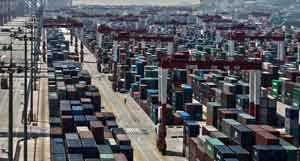News >> World
Study reveals ‘true’ cost of imports
 04 Sep, 2013
04 Sep, 2013
Current methods of measuring the full material cost of imported goods are highly inaccurate say researchers, reports BBC.
In a new study, they found that three times as many raw materials are used to process and export traded goods than are used in their manufacture.
Richer countries who believe they have succeeded in developing sustainably are mistaken say the authors.
The research has been published in the Proceedings of the National Academy of Sciences.
Many developed nations believe they are on a path to sustainable development, as their economic growth has risen over the past 20 years but the level of raw materials they are consuming has declined.
But this new study indicates that these countries are not including the use of raw materials that never leave their country of origin.
Heavy footprints
The researchers used a new model that looked at metal ores, biomass, fossil fuels and construction materials to produce what they say is a more comprehensive picture of the "material footprint" of 186 countries over a 20 year period.
In 2008, around 70bn tonnes of raw materials were extracted worldwide but just 10bn tonnes were physically traded. Over 40% were used to enable the processing and export of these materials.
"By relying on current indicators, governments are not able to see the true extent of resource consumption," said Dr Tommy Wiedmann from the University of New South Wales.
"The trade figure just looks at the physical amounts of material traded, but it doesn't take into account the materials that are used to produce these goods that are traded - so for something like fertiliser, you need to mine phosphate rocks, you need machinery, so you need extra materials."
In this analysis, the Chinese economy had the largest material footprint, twice as large as the US and four times that of Japan and India. The majority comes from construction minerals, reflecting the rapid industrialisation and urbanisation in China over the past 20 years.
The US is by far the largest importer of these primary resources when they are included in trade.
Per capita, the picture is different, with the largest exporters of embodied raw materials being Australia and Chile.
Cutting at source
According to this model, South Africa was the only country which had increased growth and decreased consumption of materials.
"We are saying there is something missing, if we only look at the one indicator we get the wrong information," said Dr Wiedmann.
The researchers believe their analysis shows that the pressure on raw materials doesn't necessarily decline as affluence grows. They argue that humanity is using natural materials at a level never seen before, with far-reaching environmental consequences.
They hope the new material footprint model will inform the sustainable management of resources such as water. The authors believe it could lead to fairer and more effective climate agreements.
"Countries could think about agreements where they help reduce the emissions at that point of material use," said Dr Wiedmann.
"That's where it is cheapest to do, where it is most efficient, where it makes more sense.
Source: natunbarta

